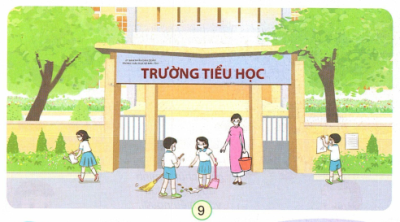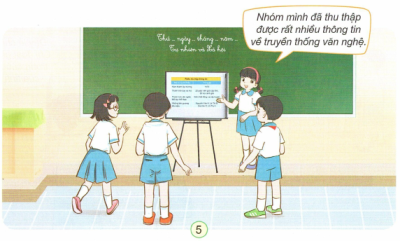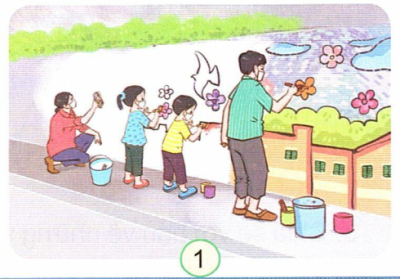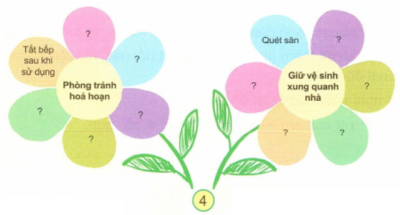Hướng dẫn dạy Unit: Starter - Tiếng Anh 3 Global success
Hướng dẫn dạy Unit: Starter - Tiếng Anh 3 Global success
Starter
Objectives
By the end of the Starter unit, pupils will be able to:
- identify the numbers 1 to 10 through listening, speaking, reading and writing activities;
- identify the letters of the alphabet through listening, speaking, reading and writing activities;
- play the game Bingo to review the numbers from one to ten and letters of the alphabet
Objectives
By the end of the Starter unit, pupils will be able to:
- identify the numbers 1 to 10 through listening, speaking, reading and writing activities;
- identify the letters of the alphabet through listening, speaking, reading and writing activities;
- play the game Bingo to review the numbers from one to ten and letters of the alphabet
Period 1
A. NUMBERS
Warm-up
- Greet the class: "Hello.'' Reinforce the meaning by smiling and waving. Encourage pupils to respond with "Hello" and copy the action. Repeat the procedure a few times.
- Tell pupils to open their books on page 7 and look at Starter, A. Numbers. Write the title Numbers on the board and tell pupils what they will learn in this lesson.
1. Listen, point and repeat.
Goal: To listen, point at and repeat the numbers 1-10 correctly.
Input:
-Numbers 1-10
- Audio recording of the numbers 1-10
Procedure:
Step 1: Draw pupils'attention to the numbers. Tell them to listen, point at the numbers and repeat. Play the recording for pupils to listen to the numbers, and familiarise themselves with their stress and intonation.
Step 2: Play the recording again for pupils to listen and repeat. Remind them to point at the numbers while listening. Do this several times until they feel confident. Correct their pronunciation where necessary.
Step 3: Put pupils into pairs to practise listening, pointing at and repeating the numbers 1 - 10. Go around the classroom to offer support.
Outcome: Pupils can listen, point at and repeatthe numbers 1 - 10 correctly.
2. Listen and tick.
Goal: To listen to and identify the numbers by ticking the correct boxes.
Input: Numbers 1 - 10 with boxes for ticking
Audio script: three, five, eight, ten
Procedure:
Step 1: Draw pupils'attention to the numbers. Tell them to listen and tick the correct boxes while listening. Give an example by playing the recording for three and ticking the correct box.
Step 2: Play the recording all the way through for pupils to do the task. Play the recording again forthem to check their answers.
Step 3: Get pupils to swap books with a partner, then check answers together as a class. Write the correct answers on the board.
Step 4: Play the recording again for pupils to double-check their answers.
Extension: If time allows, play the recording, number by number, for the class to listen and repeat in chorus. Correct their pronunciation where necessary.
Outcome: Pupils can listen to and identify the numbers by ticking the correct boxes.
Key: 3 5 8 10
3. Read and match.
Goal: To read and match the relevant words with numbers.
Input: Two columns: numbers in word and numeral form
Procedure:
Step 1: Divide the board into two columns and write the numbers in word and numeral form. Tell pupils to read the words and draw lines to match the numbers. Give an example by having pupils read the word in chorus and drawing a line to match it to the number 1.
Step 2: Give pupils time to do the task individually or in pairs. Go around the classroom to offer support where necessary.
Step 3: Check the answers as a class. Then invite a pupil to come to the front and draw lines on the board to match the words with the relevant numbers.
Outcome: Pupils can read and match words with the relevant numbers.
Key: 2.e 3. b 4. a 5. d
B. THE ALPHABET
Warm-up
- Greet the class. Encourage to respond to your greeting.
- Tell pupils to open their books on page 8 and look at B. The alphabet. Write the title The alphabet on the board and tell pupils what they will learn in this lesson.
1. Listen, point and sing.
Goal: To identify the letters of the alphabet by correctly pointing at, singing and performing The alphabet song with the correct pronunciation and melody.
Input: The lyricsand the recording of The alphabet song
Procedure:
Step 1: Draw pupils'attention to the title and lyrics of the song. Check comprehension.
Step 2: Play the recording all the way through for pupils to listen carefully to the pronunciation and the melody.
Step 3: Play the recording again for pupils to listen and repeat. Do this several times until they feel confident. Correct their pronunciation where necessary.
Step 4: Play the recording all the way through for pupils to sing along.
Step 5: Show pupils actions to do while singing along with the recording, for example, use a finger to draw the letters in the air while singing.
Extension: Put pupils into groups to make up their own actions for the song. Invite groups to the front of the classroom to sing and perform the song while the rest of the class sings and / or claps along. Encourage the class to praise or cheer the performers.
Outcome: Pupils can identify the letters of the alphabet by pointing at, singing, and performing The alphabet song with the correct pronunciation and melody.
2. Read and complete.
Goal: To identify and complete the missing letters of the alphabet.
Input: The incomplete alphabet with three missing letters
Procedure:
- Step 1: Draw pupils'attention to the incomplete alphabet. Point at the letters for pupils to read, then elicit each missing letter and give feedback. Write the answers on the board, then have pupils read the full alphabet in chorus.
- Step 2: Give pupils time to do the task individually or in pairs. Go around the classroom to offer support where necessary.
- Step 3: Invite a pupil to stand up and say the missing letters. Correct their pronunciation where necessary. Write the answers on the board for the class to check their answers.
Extension: Have the class sing The alphabet song a few times.
Outcome: Pupils can identify the alphabet letters and complete the missing letters.
Key: 1.F 2. J 3.Z
3. Count the letters.
Goal: To count the letters in the target names.
Input: Three names: BEN, MARY and LINDA
Procedure:
- Step 1: Draw pupils'attention to the target names. Point at the first name, BEN, and have pupils count the letters by reading the numbers under the letters. Point at the numbers and say that it is the total number of the letters in the name BEN. Get the class to count the letters again in chorus.
- Step 2: Give pupils time to do the task individually or in pairs. Go around the classroom to offer support where necessary.
- Step 3: Invite a pupil to stand up and count the letters in the names.
Outcome: Pupils can count the letters in the target names.
Key: 2.4 3. 5
Warm-up
- Greet the class: "Hello.'' Reinforce the meaning by smiling and waving. Encourage pupils to respond with "Hello" and copy the action. Repeat the procedure a few times.
- Tell pupils to open their books on page 7 and look at Starter, A. Numbers. Write the title Numbers on the board and tell pupils what they will learn in this lesson.
1. Listen, point and repeat.
Goal: To listen, point at and repeat the numbers 1-10 correctly.
Input:
-Numbers 1-10
- Audio recording of the numbers 1-10
Procedure:
Step 1: Draw pupils'attention to the numbers. Tell them to listen, point at the numbers and repeat. Play the recording for pupils to listen to the numbers, and familiarise themselves with their stress and intonation.
Step 2: Play the recording again for pupils to listen and repeat. Remind them to point at the numbers while listening. Do this several times until they feel confident. Correct their pronunciation where necessary.
Step 3: Put pupils into pairs to practise listening, pointing at and repeating the numbers 1 - 10. Go around the classroom to offer support.
Outcome: Pupils can listen, point at and repeatthe numbers 1 - 10 correctly.
2. Listen and tick.
Goal: To listen to and identify the numbers by ticking the correct boxes.
Input: Numbers 1 - 10 with boxes for ticking
Audio script: three, five, eight, ten
Procedure:
Step 1: Draw pupils'attention to the numbers. Tell them to listen and tick the correct boxes while listening. Give an example by playing the recording for three and ticking the correct box.
Step 2: Play the recording all the way through for pupils to do the task. Play the recording again forthem to check their answers.
Step 3: Get pupils to swap books with a partner, then check answers together as a class. Write the correct answers on the board.
Step 4: Play the recording again for pupils to double-check their answers.
Extension: If time allows, play the recording, number by number, for the class to listen and repeat in chorus. Correct their pronunciation where necessary.
Outcome: Pupils can listen to and identify the numbers by ticking the correct boxes.
Key: 3 5 8 10
3. Read and match.
Goal: To read and match the relevant words with numbers.
Input: Two columns: numbers in word and numeral form
Procedure:
Step 1: Divide the board into two columns and write the numbers in word and numeral form. Tell pupils to read the words and draw lines to match the numbers. Give an example by having pupils read the word in chorus and drawing a line to match it to the number 1.
Step 2: Give pupils time to do the task individually or in pairs. Go around the classroom to offer support where necessary.
Step 3: Check the answers as a class. Then invite a pupil to come to the front and draw lines on the board to match the words with the relevant numbers.
Outcome: Pupils can read and match words with the relevant numbers.
Key: 2.e 3. b 4. a 5. d
B. THE ALPHABET
Warm-up
- Greet the class. Encourage to respond to your greeting.
- Tell pupils to open their books on page 8 and look at B. The alphabet. Write the title The alphabet on the board and tell pupils what they will learn in this lesson.
1. Listen, point and sing.
Goal: To identify the letters of the alphabet by correctly pointing at, singing and performing The alphabet song with the correct pronunciation and melody.
Input: The lyricsand the recording of The alphabet song
Procedure:
Step 1: Draw pupils'attention to the title and lyrics of the song. Check comprehension.
Step 2: Play the recording all the way through for pupils to listen carefully to the pronunciation and the melody.
Step 3: Play the recording again for pupils to listen and repeat. Do this several times until they feel confident. Correct their pronunciation where necessary.
Step 4: Play the recording all the way through for pupils to sing along.
Step 5: Show pupils actions to do while singing along with the recording, for example, use a finger to draw the letters in the air while singing.
Extension: Put pupils into groups to make up their own actions for the song. Invite groups to the front of the classroom to sing and perform the song while the rest of the class sings and / or claps along. Encourage the class to praise or cheer the performers.
Outcome: Pupils can identify the letters of the alphabet by pointing at, singing, and performing The alphabet song with the correct pronunciation and melody.
2. Read and complete.
Goal: To identify and complete the missing letters of the alphabet.
Input: The incomplete alphabet with three missing letters
Procedure:
- Step 1: Draw pupils'attention to the incomplete alphabet. Point at the letters for pupils to read, then elicit each missing letter and give feedback. Write the answers on the board, then have pupils read the full alphabet in chorus.
- Step 2: Give pupils time to do the task individually or in pairs. Go around the classroom to offer support where necessary.
- Step 3: Invite a pupil to stand up and say the missing letters. Correct their pronunciation where necessary. Write the answers on the board for the class to check their answers.
Extension: Have the class sing The alphabet song a few times.
Outcome: Pupils can identify the alphabet letters and complete the missing letters.
Key: 1.F 2. J 3.Z
3. Count the letters.
Goal: To count the letters in the target names.
Input: Three names: BEN, MARY and LINDA
Procedure:
- Step 1: Draw pupils'attention to the target names. Point at the first name, BEN, and have pupils count the letters by reading the numbers under the letters. Point at the numbers and say that it is the total number of the letters in the name BEN. Get the class to count the letters again in chorus.
- Step 2: Give pupils time to do the task individually or in pairs. Go around the classroom to offer support where necessary.
- Step 3: Invite a pupil to stand up and count the letters in the names.
Outcome: Pupils can count the letters in the target names.
Key: 2.4 3. 5
Period 3
C. FUNTIME
Warm-up
- Greet the class. Encourage pupils to respond to your greeting.
- Get pupils to sing The alphabet song. Then tell them to open their books on page 9 and look at C. Fun time.
1. Count one to ten.
Goal: To review the numbers 1 - 10 by counting on fingers.
Input: Picture cues of the hands showing numbers 1-10
Procedure:
- Step 1: Draw pupils' attention to the pictures of the hands. Show them how to use their fingers to count from one to ten, and practise a few times until they feel confident.
- Step 2: Give pupils time to do the task individually or in pairs. Go around the classroom to offer support.
- Step 3: Invite a few pupils to the front of the classroom to take turns to perform the task. Get the class to vote for the best performer.
Outcome: Pupils can review the numbers from one to ten by using their fingers to count.
2. Let's play.
Bingo
Goal: To review the numbers 1 - 10and the letters of the alphabet by playing the game Bingo.
Input: Two 3x3 Bingo grids, one filled with nine numbers, another filled with nine letters of the alphabet
Procedure:
- Step 1: Draw a 3x3 Bingo grid on the board and get pupils to do the same in their notebooks.
Tell pupils to complete their grids with any numbers from one to ten. Explain how to play the game: You call out a number. Every pupil that has that number in his or her grid should cross it out.
Continue to call outnumbers (remember to keep a record!) until someone shouts Bingo! Check his / her grid to make sure that he or she has crossed out the numbers that you have called, then declare him or her the winner.
Step 2: Repeat the same procedure with the Bingo grid filled with the letters of the alphabet.
Extension: Iftimeallows, have pupils countfrom oneto ten, and sing The alphabet song in chorus.
Outcome: Pupils can review the numbers from one to ten and the alphabet letters by playing the game Bingo.
Warm-up
- Greet the class. Encourage pupils to respond to your greeting.
- Get pupils to sing The alphabet song. Then tell them to open their books on page 9 and look at C. Fun time.
1. Count one to ten.
Goal: To review the numbers 1 - 10 by counting on fingers.
Input: Picture cues of the hands showing numbers 1-10
Procedure:
- Step 1: Draw pupils' attention to the pictures of the hands. Show them how to use their fingers to count from one to ten, and practise a few times until they feel confident.
- Step 2: Give pupils time to do the task individually or in pairs. Go around the classroom to offer support.
- Step 3: Invite a few pupils to the front of the classroom to take turns to perform the task. Get the class to vote for the best performer.
Outcome: Pupils can review the numbers from one to ten by using their fingers to count.
2. Let's play.
Bingo
Goal: To review the numbers 1 - 10and the letters of the alphabet by playing the game Bingo.
Input: Two 3x3 Bingo grids, one filled with nine numbers, another filled with nine letters of the alphabet
Procedure:
- Step 1: Draw a 3x3 Bingo grid on the board and get pupils to do the same in their notebooks.
Tell pupils to complete their grids with any numbers from one to ten. Explain how to play the game: You call out a number. Every pupil that has that number in his or her grid should cross it out.
Continue to call outnumbers (remember to keep a record!) until someone shouts Bingo! Check his / her grid to make sure that he or she has crossed out the numbers that you have called, then declare him or her the winner.
Step 2: Repeat the same procedure with the Bingo grid filled with the letters of the alphabet.
Extension: Iftimeallows, have pupils countfrom oneto ten, and sing The alphabet song in chorus.
Outcome: Pupils can review the numbers from one to ten and the alphabet letters by playing the game Bingo.
Ý kiến bạn đọc



